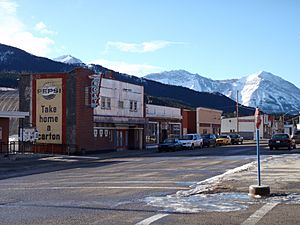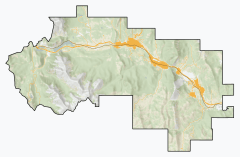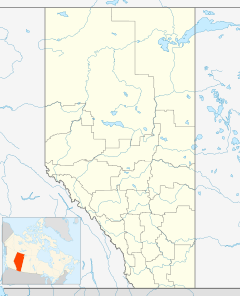Coleman, Alberta facts for kids
Quick facts for kids
Coleman
|
|
|---|---|
|
Unincorporated community
|
|
 |
|
| Country | Canada |
| Province | Alberta |
| Specialized municipality | Municipality of Crowsnest Pass |
| Village | 11 January 1904 |
| Town | 10 September 1910 |
| Amalgamated | 1 January 1979 |
| Government | |
| • Type | Unincorporated |
| Area | |
| • Land | 1.99 km2 (0.77 sq mi) |
| Elevation | 1,320 m (4,330 ft) |
| Population
(2021)
|
|
| • Total | 1,441 |
| • Density | 724.1/km2 (1,875/sq mi) |
| Time zone | UTC−7 (MST) |
| • Summer (DST) | UTC−6 (MDT) |
Coleman is a small community nestled in the Rocky Mountains of southwest Alberta, Canada. It's part of the larger Municipality of Crowsnest Pass. Before 1979, Coleman was its own town. Then, it joined with four other nearby communities to form the Crowsnest Pass area we know today.
Coleman is located in a region called Census Division No. 15. You can reach it by Highway 3, also known as the Crowsnest Highway, or by the Canadian Pacific Railway.
Contents
History of Coleman
In 1903, a new settlement was planned a few kilometers west of Blairmore. This new place was built to support a new coal mine. The mine was run by the International Coal and Coke Company. The community was first called Paulson's Camp or McGillivray Hill. However, the post office didn't approve these names. So, it was named Coleman. This name came from the middle name of the mine owner's youngest daughter.
From Village to Town
Coleman officially became a village on January 11, 1904. It grew quickly and became a town on September 10, 1910.
A special part of Coleman was its 100 (later 216) coke ovens. These ovens were located just outside the town. They turned coal into coke, a type of fuel. These ovens operated from 1906 to 1952. Coleman grew very fast, even becoming bigger than its neighbor, Blairmore, for a while. The town even had an opera house from 1908 until it burned down in 1948.
Challenges and Changes
Coleman faced many challenges over the years. There were worker strikes in 1911 and 1932. The town also experienced floods in 1923 and 1942, and fires in 1948. As the coal mines in the area slowly closed down, Coleman became less important for business. Blairmore then became the main commercial center.
On January 1, 1979, the Town of Coleman officially joined with four other communities. These were the Village of Bellevue, the Town of Blairmore, the Village of Frank, and Improvement District No. 5. This joining is called an amalgamation. Together, they formed the Municipality of Crowsnest Pass.
Coleman's Mining Heritage
Coleman's past as a coal mining town is still very clear today. You can see many historic buildings. There's also a regional museum. You can visit the ruins of its old coal plant and coke ovens. Several old, unused mines are nearby. One unique feature is the "biggest piggy bank in the world." It's made from an old mine locomotive. A large part of the downtown area is now a special place called the Coleman National Historic Site.
Geography and Climate
Coleman is located in a beautiful mountain setting.
Climate in Coleman
Coleman has a subarctic climate (Dfc). This means it has mild to warm summers. The winters are cold and snowy.
| Climate data for Coleman | |||||||||||||
|---|---|---|---|---|---|---|---|---|---|---|---|---|---|
| Month | Jan | Feb | Mar | Apr | May | Jun | Jul | Aug | Sep | Oct | Nov | Dec | Year |
| Record high °C (°F) | 11.5 (52.7) |
13.9 (57.0) |
18.3 (64.9) |
25.6 (78.1) |
29.0 (84.2) |
30.0 (86.0) |
35.0 (95.0) |
34.0 (93.2) |
32.0 (89.6) |
26.0 (78.8) |
16.0 (60.8) |
13.5 (56.3) |
35.0 (95.0) |
| Mean daily maximum °C (°F) | −1.6 (29.1) |
0.1 (32.2) |
4.6 (40.3) |
9.5 (49.1) |
14.4 (57.9) |
18.7 (65.7) |
22.1 (71.8) |
22.8 (73.0) |
17.0 (62.6) |
10.2 (50.4) |
1.4 (34.5) |
−3.0 (26.6) |
9.7 (49.5) |
| Daily mean °C (°F) | −6.4 (20.5) |
−5.0 (23.0) |
−0.8 (30.6) |
3.6 (38.5) |
7.9 (46.2) |
11.8 (53.2) |
14.3 (57.7) |
14.3 (57.7) |
9.5 (49.1) |
4.6 (40.3) |
−2.7 (27.1) |
−7.4 (18.7) |
3.6 (38.5) |
| Mean daily minimum °C (°F) | −11.3 (11.7) |
−10.1 (13.8) |
−6.2 (20.8) |
−2.4 (27.7) |
1.3 (34.3) |
4.9 (40.8) |
6.5 (43.7) |
5.7 (42.3) |
2.0 (35.6) |
−1.1 (30.0) |
−6.8 (19.8) |
−11.9 (10.6) |
−2.4 (27.7) |
| Record low °C (°F) | −39.4 (−38.9) |
−37.5 (−35.5) |
−37.2 (−35.0) |
−24.4 (−11.9) |
−8.3 (17.1) |
−5.6 (21.9) |
−3.3 (26.1) |
−7.0 (19.4) |
−11.0 (12.2) |
−27.0 (−16.6) |
−37.0 (−34.6) |
−41.1 (−42.0) |
−41.1 (−42.0) |
| Average precipitation mm (inches) | 34.8 (1.37) |
37.1 (1.46) |
38.6 (1.52) |
39.8 (1.57) |
69.6 (2.74) |
70.2 (2.76) |
62.6 (2.46) |
43.7 (1.72) |
45.9 (1.81) |
46.4 (1.83) |
56.2 (2.21) |
37.3 (1.47) |
582.1 (22.92) |
| Average rainfall mm (inches) | 12.7 (0.50) |
10.8 (0.43) |
13.0 (0.51) |
23.0 (0.91) |
60.8 (2.39) |
70.2 (2.76) |
62.6 (2.46) |
43.2 (1.70) |
44.3 (1.74) |
32.8 (1.29) |
22.4 (0.88) |
9.2 (0.36) |
404.8 (15.94) |
| Average snowfall cm (inches) | 22.1 (8.7) |
26.4 (10.4) |
25.6 (10.1) |
16.7 (6.6) |
8.8 (3.5) |
0.0 (0.0) |
0.0 (0.0) |
0.5 (0.2) |
1.7 (0.7) |
13.6 (5.4) |
33.9 (13.3) |
28.1 (11.1) |
177.3 (69.8) |
| Source: Environment Canada | |||||||||||||
Population Information
Every few years, Statistics Canada counts how many people live in different areas. This is called a census.
| Population history of Coleman | |||||||||||||||||||||||||||||||||||||||||||||||||||||||||||||||||
|---|---|---|---|---|---|---|---|---|---|---|---|---|---|---|---|---|---|---|---|---|---|---|---|---|---|---|---|---|---|---|---|---|---|---|---|---|---|---|---|---|---|---|---|---|---|---|---|---|---|---|---|---|---|---|---|---|---|---|---|---|---|---|---|---|---|
|
|
|
|||||||||||||||||||||||||||||||||||||||||||||||||||||||||||||||
| Source: Statistics Canada | |||||||||||||||||||||||||||||||||||||||||||||||||||||||||||||||||
In the 2021 Census, Coleman had a population of 1,441 people. They lived in 722 homes. This was a small decrease from its 2016 population of 1,475 people. Coleman covers an area of about 1.99 square kilometers (0.77 square miles). In 2021, this meant there were about 724 people living per square kilometer.
In the 2016 Census, Coleman had 1,475 people living in 696 homes. This was an increase from its 2011 population of 1,366 people.
Notable People
- Joe Kryczka: He was a judge for the Court of Queen's Bench of Alberta. He also served as the president of the Canadian Amateur Hockey Association.



